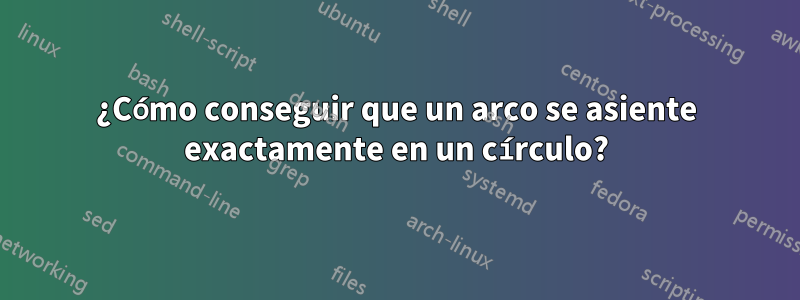
He creado la siguiente figura:

Con este segmento:
\documentclass[a4paper,12pt]{article}
\usepackage{parskip}
\usepackage{amssymb}
\usepackage[fleqn]{amsmath}
\usepackage[svgnames]{xcolor}
\usepackage{tikz}
\usetikzlibrary{patterns}
\usetikzlibrary{fadings}
\setlength{\mathindent}{0pt}
\usepackage{color}
\usepackage{fixltx2e}
\usepackage{pgfplots}
\usepackage{graphicx}
\newcommand{\func}[1]{\operatorname{#1}}
\newcommand{\var}[1]{\mathit{#1}}
\begin{document}
\begin{center}
\begin{tikzpicture}[scale=0.9]
\draw[->] (-6,0) -- (5,0) node[right] {$x$};
\draw[->] (-5,-1) -- (-5,5) node[above] {$y$};
\draw (-2.5,1.5) circle (1cm) node[xshift=30, yshift=20] {$R_1$};
\draw (1.5,3) circle (1.5cm) node[xshift=40, yshift=30] {$R_2$};
\draw [decorate,decoration={brace}]
(-5.2,1.5) -- (-5.2,2.5) node [black,midway, xshift=-0.4cm]
{\footnotesize \rotatebox{90}{$\exists x R_1\cap \exists x R_2$}};
\draw[thick,purple] (-5,1.5) -- (-5,2.5);
\fill[opacity=0.5, color=purple, path fading=east] (-5,1.5) rectangle (6,2.5);
\fill[opacity=0.5, color=purple, path fading=west] (-5.3,1.5) rectangle (-5,2.5);
\end{tikzpicture}
\end{center}
\end{document}
Consideremos ahora el círculo R_2. Quiero marcar la parte que está dentro del área coloreada con violeta.
Calculé el punto en el que el perímetro del círculo se cruza con el borde del área coloreada y encontré que es (2.91,2.5). Entonces intenté agregar un arco. Pero eso no salió bien...
Aquí está la adición:
\documentclass[a4paper,12pt]{article}
\usepackage{parskip}
\usepackage{amssymb}
\usepackage[fleqn]{amsmath}
\usepackage[svgnames]{xcolor}
\usepackage{tikz}
\usetikzlibrary{patterns}
\usetikzlibrary{fadings}
\setlength{\mathindent}{0pt}
\usepackage{color}
\usepackage{fixltx2e}
\usepackage{pgfplots}
\usepackage{graphicx}
\newcommand{\func}[1]{\operatorname{#1}}
\newcommand{\var}[1]{\mathit{#1}}
\begin{document}
\begin{center}
\begin{tikzpicture}[scale=0.9]
\draw[->] (-6,0) -- (5,0) node[right] {$x$};
\draw[->] (-5,-1) -- (-5,5) node[above] {$y$};
\draw (-2.5,1.5) circle (1cm) node[xshift=30, yshift=20] {$R_1$};
\draw (1.5,3) circle (1.5cm) node[xshift=40, yshift=30] {$R_2$};
\draw [decorate,decoration={brace}]
(-5.2,1.5) -- (-5.2,2.5) node [black,midway, xshift=-0.4cm]
{\footnotesize \rotatebox{90}{$\exists x R_1\cap \exists x R_2$}};
\draw[thick,purple] (-5,1.5) -- (-5,2.5);
\fill[opacity=0.5, color=purple, path fading=east] (-5,1.5) rectangle (6,2.5);
\fill[opacity=0.5, color=purple, path fading=west] (-5.3,1.5) rectangle (-5,2.5);
% addition here!
\draw[thick, color=purple] (2.91,2.5) arc[radius = 1.5cm, start angle= 0, end angle= -140];
\end{tikzpicture}
\end{center}
\end{document}
Esta adición no dibujó el arco exactamente en el círculo R_2:

No importa qué valores usé, no pude lograr que este arco se ubicara exactamente en el perímetro del círculo...
Espero que mi publicación sea lo suficientemente clara, ya que no hablo inglés.
Gracias de antemano.
Respuesta1
Tienes que elegir los ángulos adecuados para el arco. Pero lo más fácil es recortar
% addition here!
\begin{scope}
\clip (-5,1.5) rectangle (6,2.5);
\draw[thick, color=purple] (1.5,3) circle (1.5cm);
\end{scope}
Código:
\documentclass[a4paper,12pt]{article}
%% why so many packages for a MWE?
\usepackage{parskip}
\usepackage{amssymb}
\usepackage[fleqn]{amsmath}
\usepackage[svgnames]{xcolor}
\usepackage{tikz}
\usetikzlibrary{patterns}
\usetikzlibrary{fadings}
\setlength{\mathindent}{0pt}
\usepackage{color}
\usepackage{fixltx2e}
\usepackage{pgfplots}
\usepackage{graphicx}
\newcommand{\func}[1]{\operatorname{#1}}
\newcommand{\var}[1]{\mathit{#1}}
\begin{document}
\begin{center}
\begin{tikzpicture}[scale=0.9]
\draw[->] (-6,0) -- (5,0) node[right] {$x$};
\draw[->] (-5,-1) -- (-5,5) node[above] {$y$};
\draw (-2.5,1.5) circle (1cm) node[xshift=30, yshift=20] {$R_1$};
\draw (1.5,3) circle (1.5cm) node[xshift=40, yshift=30] {$R_2$};
\draw [decorate,decoration={brace}]
(-5.2,1.5) -- (-5.2,2.5) node [black,midway, xshift=-0.4cm]
{\footnotesize \rotatebox{90}{$\exists x R_1\cap \exists x R_2$}};
\draw[thick,purple] (-5,1.5) -- (-5,2.5);
\fill[opacity=0.5, color=purple, path fading=east] (-5,1.5) rectangle (6,2.5);
\fill[opacity=0.5, color=purple, path fading=west] (-5.3,1.5) rectangle (-5,2.5);
% addition here!
\begin{scope}
\clip (-5,1.5) rectangle (6,2.5);
\draw[thick, color=purple] (1.5,3) circle (1.5cm);
\end{scope}
\end{tikzpicture}
\end{center}
\end{document}

Con arco, algo como
% addition here!
\draw[thick, color=purple] (2.91,2.5) arc[radius = 1.5cm, start angle= -20, end angle= -160];
debería darte el arco en el círculo.
Respuesta2
Los ángulos se pueden calcular fácilmente usando el triángulo rectangular anotado:
\documentclass[a4paper,12pt]{article}
\usepackage[svgnames]{xcolor}
\usepackage{tikz}
\usetikzlibrary{patterns}
\usetikzlibrary{fadings}
\usetikzlibrary{decorations, decorations.pathreplacing}
\begin{document}
\begin{center}
\begin{tikzpicture}[scale=0.9]
\draw[->] (-6,0) -- (5,0) node[right] {$x$};
\draw[->] (-5,-1) -- (-5,5) node[above] {$y$};
\draw (-2.5,1.5) circle (1cm) node[xshift=30, yshift=20] {$R_1$};
\draw (1.5,3) circle (1.5cm) node[xshift=40, yshift=30] {$R_2$};
\draw [decorate,decoration={brace}]
(-5.2,1.5) -- (-5.2,2.5) node [black,midway, xshift=-0.4cm]
{\footnotesize \rotatebox{90}{$\exists x R_1\cap \exists x R_2$}};
\draw[thick,purple] (-5,1.5) -- (-5,2.5);
\fill[opacity=0.5, color=purple, path fading=east] (-5,1.5)
rectangle (6,2.5);
\fill[opacity=0.5, color=purple, path fading=west] (-5.3,1.5)
rectangle (-5,2.5);
% addition here!
% \draw[thick, color=purple] (2.91,2.5) arc[radius = 1.5cm, start
% angle= 0, end angle= -140];
\pgfmathsetmacro\angle{acos(1/3)}
\draw[thick, color=purple, radius=1.5cm]
(1.5, 3) ++(270-\angle:1.5cm) coordinate (start)
arc[start angle=270-\angle, end angle=270+\angle];
\draw[thin, node font=\scriptsize]
(1.5, 3) node[above] {acos(0.5/1.5)}
-- node[right] {0.5} (1.5, 2.5)
-- (start) -- node[above left] {1.5} cycle;
\end{tikzpicture}
\end{center}
\end{document}
Respuesta3
Aquí se explica cómo realizar el enfoque de recorte más general y simple en Metapost.

(He omitido el desvanecimiento y el refuerzo, pero podrían agregarse con un poco más de esfuerzo).
prologues := 3;
outputtemplate := "%j%c.eps";
beginfig(1);
color purple; purple = 3/4 red + 1/4 blue;
path xx, yy, r[], band;
u = 1cm;
xx = (left -- 10 right) scaled u;
yy = (down -- 5 up) scaled u;
r1 = fullcircle scaled 2u shifted (2.5u,1.5u);
r2 = fullcircle scaled 3u shifted (6.5u,3u);
band = unitsquare xscaled 10u yscaled (ypart point 2 of r1 - ypart point 6 of r2)
shifted (-1/4u, ypart point 6 of r2);
fill band withcolor .85[purple,white];
label.lft(btex $\exists x R_1 \cap \exists x R_2$ etex rotated 90, point 3.5 of band);
draw r1; label.lrt(btex $R_1$ etex, point 7 of r1);
draw r2; label.urt(btex $R_2$ etex, point 1 of r2);
drawarrow xx; label.rt (btex $x$ etex, point 1 of xx);
drawarrow yy; label.top(btex $y$ etex, point 1 of yy);
picture overlay;
overlay = image(
drawoptions(withcolor purple);
% draw r1; <--- you could add this one too if you wanted
draw r2;
draw yy;
drawoptions();
);
clip overlay to band; draw overlay;
endfig;
end.
La ventaja de este enfoque es que el arco rojo se dibuja correctamente automáticamente si se mueve cualquiera de los círculos y no se necesitan cálculos.
Es útil saber que en MP simple una línea recta comienza en el punto 0 y va al punto 1, y hay 8 "puntos" en un círculo en MP simple con el punto 0 a las 3 en punto, así:




